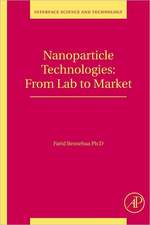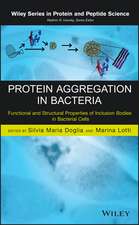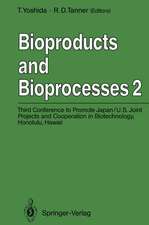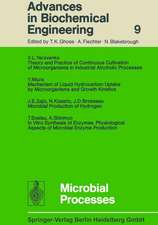Phase-Transfer Catalysis: Fundamentals, Applications, and Industrial Perspectives
Autor C.M. Starks, M. Halperen Limba Engleză Hardback – 30 iun 1994
| Toate formatele și edițiile | Preț | Express |
|---|---|---|
| Paperback (1) | 1235.25 lei 6-8 săpt. | |
| SPRINGER NETHERLANDS – 3 oct 2013 | 1235.25 lei 6-8 săpt. | |
| Hardback (1) | 1240.79 lei 6-8 săpt. | |
| SPRINGER NETHERLANDS – 30 iun 1994 | 1240.79 lei 6-8 săpt. |
Preț: 1240.79 lei
Preț vechi: 1513.16 lei
-18% Nou
Puncte Express: 1861
Preț estimativ în valută:
237.43€ • 248.52$ • 197.61£
237.43€ • 248.52$ • 197.61£
Carte tipărită la comandă
Livrare economică 31 martie-14 aprilie
Preluare comenzi: 021 569.72.76
Specificații
ISBN-13: 9780412040719
ISBN-10: 0412040719
Pagini: 668
Ilustrații: XIV, 668 p.
Dimensiuni: 155 x 235 x 42 mm
Greutate: 1.11 kg
Ediția:1994
Editura: SPRINGER NETHERLANDS
Colecția Springer
Locul publicării:Dordrecht, Netherlands
ISBN-10: 0412040719
Pagini: 668
Ilustrații: XIV, 668 p.
Dimensiuni: 155 x 235 x 42 mm
Greutate: 1.11 kg
Ediția:1994
Editura: SPRINGER NETHERLANDS
Colecția Springer
Locul publicării:Dordrecht, Netherlands
Public țintă
ResearchCuprins
1: Basic Concepts in Phase-Transfer Catalysis.- A. Phase-Transfer-Catalyzed Reactions.- B. Basic Steps of Phase-Transfer Catalysis.- C. The PTC Reaction Rate Matrix.- D. Anion Transfer and Anion Activation.- E. Effect of Reaction Variables on Transfer and Intrinsic Rates.- F. Outline of Compounds Used as Phase-Transfer Catalysts.- 2: Phase-Transfer Catalysts: Fundamentals I.- A. Introduction.- B. Structural Factors Affecting the Distribution of Anions Between Aqueous and Organic Phases.- C. Structural Factors Affecting the Distribution of Phase-Transfer Catalyst Cations Between the Aqueous and Organic Phases.- D. Effects of the Organic Phase Polarity on the Distribution of Phase-Transfer Cation-Anion Pairs.- E. Effects of Changes in Organic Phase Polarity During Reaction.- F. Factors Affecting the Distribution of Phase-Transfer Catalyst Cation-Anion Pairs Between an Organic Phase and an Aqueous Phase Containing Hydroxide Ion.- G. Effect of Hydration of the Transferred Anion and the Effect of Inorganic Salt and/or Hydroxide Concentration in the Aqueous Phase.- 3: Phase-Transfer Catalysis: Fundamentals II.- A. Introduction.- B. Liquid-Liquid PTC.- C. Solid-Liquid PTC.- 4: Phase-Transfer Catalysts.- A. Introduction.- B. Use of Quaternary Salts as Phase-Transfer Catalysts.- C. Macrocyclic and Macrobicyclic Ligands.- D. PEGs, Tris (3,6-dioxaheptyl)amine (TDA-1), and Related Ethoxylated Compounds as Phase-Transfer Catalysts.- E. Other Soluble Polymers and Related Multifunctional Compounds as Phase-Transfer Catalysts.- F. Use of Dual PTC Catalysts or Use of Cocatalysts in Phase-Transfer Systems.- G. Catalysts for Transfer of Species Other Than Anions.- H. Separation and Recovery of Phase-Transfer Catalysts.- 5: Insoluble Phase-Transfer Catalysts.- A. Introduction.- B. PTC Catalysts Bound to Insoluble Resins.- C. Phase-Transfer Catalysts Bound to Inorganic Solid Supports.- D. PTC Catalysts Contained in a Separate Liquid Phase (Third-Liquid-Phase Catalyst).- 6: Variables in Reaction Design for Laboratory and Industrial Applications of Phase-Transfer Catalysis.- A. Choice of Catalyst.- B. Choice of Solvent.- C. Presence of Water.- D. Agitation.- E. Choice of Anion, Leaving Group, and Counteranion.- F. Choice of Base.- G. Guidelines for Exploring New PTC Applications.- 7: Phase-Transfer Catalysis Displacement Reactions with Simple Anions.- A. General Considerations.- B. Behavior of Various Anions in PTC Displacement Reactions.- 8: Phase-Transfer Catalysis Reaction with Strong Bases.- A. C-Alkylation.- B. N-Alkylation.- C. O-Alkylation—Etherification.- D. S- Alky lation—Thioetherification.- E. Dehydrohalogenation.- F. Carbene Reactions.- G. Condensation Reactions.- H. Deuterium Exchange, Isomerization, and Oxidation.- 9: Phase-Transfer Catalysis: Polymerization and Polymer Modification.- A. Introduction.- B. Polymer Synthesis.- C. Chemical Modification of Polymers.- 10: Phase-Transfer-Catalyzed Oxidations.- A. Introduction.- B. Permanganate Oxidations.- D. PTC Oxidations with Hydrogen Peroxide.- E. PTC Air or Oxygen Oxidations.- F. Oxidations by Persulfates.- H. PTC Oxidations with Nitric Acid.- I. PTC Carbon Tetrachloride/Sodium Hydroxide Oxidations.- J. PTC Oxidations with Periodate and Related Oxidizing Anions.- K. PTC Oxidations with Perborate.- L. PTC Oxidations with Ferrate and Ferricyanide.- M. PTC Oxidations with Superoxide.- N. PTC Electrochemical Oxidations.- O. PTC Oxidations with Other Oxidants.- 11: Phase-Transfer-Catalyzed Reductions.- A. Sodium Borohydride Reductions.- B. Lithium Aluminum Hydride Reductions.- C. Reductions withSodium Formate.- D. Reductions with Sulfur-Containing Anions.- E. Hydrogenation.- F. Reductions with Formaldehyde.- G. Electrochemical Reduction.- H. Photochemical Reduction.- I. Wolff-Kishner Reduction.- J. Reduction by Dodecarbonyltriiron and Related Species.- 12: Phase-Transfer Catalysis: Chiral Phase-Transfer-Catalyzed Formation of Carbon—Carbon Bonds.- A. Introduction.- B. Alkylation Reactions.- 13: Phase Transfer Catalysis—Transition Metal Cocatalyzed Reactions.- A. Introduction.- B. Carbonylation and Reactions with Carbon Monoxide.- B. PTC Reduction and Hydrogenation with Metal Cocatalysts.- C. Coupling Reactions of Alkenes, Alkynes, and Alkyl Halides.- D. Other Reactions.- 14: Phase-Transfer Catalysis in Analytical Chemistry.- A. The PTC/Analytical Chemistry Match.- B. Esterification, Etherification, and Other Nucleophilic Derivatizations.- C. Non-Nucleophilic PTC Reactions Used in Analytical Chemistry.- 15: Phase-Transfer Catalysis: Industrial Perspectives.- A. Industrial Background.- B. Evaluation of PTC as a Commercial Manufacturing Process Technology.
Recenzii
The three authors have produced a nicely intergrated piece of work and the quality of presentation, including structures,equations, figures and graphs, is excellent...This particular textbook is likely to prove a major landmark...From time to time a textbook appears of a quality destined to make its value long-lived. This is one such example. The authors are to be congratulated on what they have achieved - Reactive Polymers; The three authors have produced a nicely intergrated piece of work and the quality of presentation, including structures,equations, figures and graphs, is excellent...This particular textbook is likely to prove a major landmark...From time to time a textbook appears of a quality destined to make its value long-lived. This is one such example. The authors are to be congratulated on what they have achieved - Reactive Polymers; The three authors have produced a nicely intergrated piece of work and the quality of presentation, including structures,equations, figures and graphs, is excellent...This particular textbook is likely to prove a major landmark...From time to time a textbook appears of a quality destined to make its value long-lived. This is one such example. The authors are to be congratulated on what they have achieved - Reactive Polymers

















